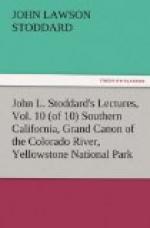and cracked, and its statues, brought a hundred years
ago from Spain, scarcely less battered than those
which the boy had shown me in the sacristy. Yet
it was plain that worshipers as well as vandals had
been here. The basins for holy water, cut in the
solid wall, were worn, like the steps of an ancient
building, with countless fingers, long since turned
to dust. There, also, were two old confessionals,
one of which was so hopelessly infirm that it had been
set aside at last, to listen to no more whispered
tales of sin and sorrow. The doors of the church
at first looked ancient, but wore a really modern
air, when compared with the original portals, which,
no longer able to stand upright, had been laid against
the wall, to show to tourists. Yet, eighty years
ago, this church stood proudly at the head of all
the Missions, and reared its cross above the richest
of their valleys. According to Father Joaquin’s
estimate, the Fathers of San Gabriel must have had
twenty thousand acres under cultivation, and, in 1820,
this Mission alone possessed one hundred and sixty
thousand vines, two thousand three hundred trees, twenty-five
thousand head of cattle, and fifteen thousand sheep.
“It was all ours,” he said, with a sweep
of his hand, “we had reclaimed it from the desert,
and, by the treaty between the United States and Mexico,
we were allowed to retain all lands that we had cultivated.
Yet of those twenty thousand acres, one hundred and
fifty are all that are left us!”
The Padre accompanied me to the station. “How
large is your parish, Father?” I asked.
“It is thirteen miles long,” was his reply,
“and I have in it eight hundred souls, but most
of them live too far away to walk to church, and are
too poor to ride.”
“And how many Indians have you?”
“Perhaps a hundred,” he answered, “and
even they are dying off.”
“What of their character?” I asked.
“They have sadly fallen away,” was the
response. “True, they are Christians as
far as they are anything, but they are hopelessly
degraded, yet they respect the Church, and are obedient
and reverential when under its influence.”
[Illustration: Discarded saints, San
Gabriel.]
[Illustration: Mutilated statues.]
[Illustration: The baptismal Font.]
[Illustration: San Gabriel, from
the southeast.]
Most of the Californian Missions are really dead,
and near that of La Purissima may still be seen the
rent in the ground made by the earthquake which destroyed
it. Others, like San Gabriel and San Juan Capistrano,
are dragging out a moribund existence, under the care
of only one or two priests, who move like melancholy
phantoms through the lonely cloisters, and pray among
the ruins of a noble past. The Mission of Santa
Barbara, however, is in fairly good repair, and a
few Franciscan Fathers still reside there and carry
on a feeble imitation of their former life.




